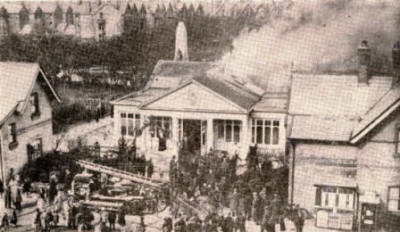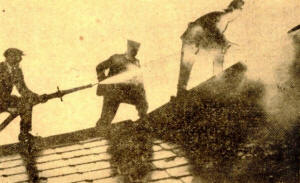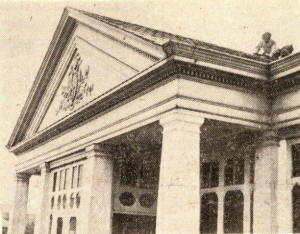|
Newspaper cutting dated March 1931
£1,300 DAMAGE.
Violinist Runs Great Risk to Save Instrument.

Many years have passed since the brigade had so serious a fire to deal with as
that which wrought extensive damage to the Ashton Pavilion, at St. Annes, on Saturday morning. It
is estimated that it will cost over £1,300 to restore the building to its former state.
The business of the town was in full swing when the alarm sounded, and people in
the vicinity of Garden Street and St. George's Road saw smoke rolling heavily over the bowling
green towards the railway. Through the town the news went quickly that the Ashton Pavilion was
alight, and from shops and cafes the customers rushed as fast as they could to the entrance to the
Gardens.
The motor engine, in charge of Supt. W. E. Mundy, dashed up quickly and long
lines of hose were unreeled in haste for the fire was making rapid headway.

THE DISCOVERY.
The first sign that anything was wrong was when painters using their brushes on
the west side noticed smoke coming from one of the ventilators on the apex of the roof. They called
to Mr. G Houghton, the caretaker, who was busy inside the hall. He too had become alarmed at the
presence of smoke in the room, and realising that something was amiss he sent for the brigade.
Meanwhile, the fire quickly gained in intensity. It was located apparently in
the roof, and owing to the strong draught between ceiling and tiles the flames were drawn to the
ventilators. These were soon emitting smoke as from the funnel of a refuelled steamship furnace.
The smoke gave place to flames, which I eventually made their appearance in the three ventilators
and rose high above the building. The roofing tiles, as they became hot under the fierce heat,
crackled like rifle fire and apiece shot off into the air.

Firemen climbed about the roof quite fearlessly, oblivious of the danger under
their feet. But they heeded not as ran about over the tiles with the spurting hose.
As the fire was subdued in one place it made its appearance in another bursting
here and there through the roof.
When the fire was at its height the auxiliary engine, from Lytham with its
additional firemen, arrived on the scene and these men gave their help in fighting the flames.
In less than an hour the fire was overcome, and one was able to survey the
destruction. This was confined to the roof and ceiling, the burnt portions of the roof covering the
space from the entrance hall to the rear of the building.
One of the spruce pillars is also very much burned.
FURNITURE REMOVED
There were marry willing helpers and the damage to the chairs and other
furniture would have been greater had it not been for the assistance so readily given.
The hall was full of dense smoke and sonic of the helpers were almost
overpowered and had to rush to the open-air to rid themselves of the choking feeling.
There were also some musical instruments and music belonging to the Bijou
Ladies' Orchestra, which played there every afternoon.

The fire was raging at its worst when Miss Gabrielle Ashworth, the talented
young local violinist, rushed frantically on the scene. She had come by bus into town and a friend
remarked that she would be having a long holiday
" Why? " enquired Gabrielle
The friend told her that the Pavilion was on fire.
“My violin!” exclaimed Miss Ashworth as she ran off to the Gardens. She had left
her valuable instrument in a locker. Heedless of fire above her head and water ankle deep, she
burst into the building, searched for the locker key and rescued her treasured violin. The drums
and other instruments belonging to Miss Nellie Bolton, and the music were also saved.
The crowd, which numbered well over a thousand, watched the work of the brigade
with interest, and when the smoke ceased to roll, when ventilators had disappeared, and the
devouring flames had died down many took glimpse of the building, around which many tender
sentiments cling. The water dripped from ten thousand places to the soaked floor, and on to a few
upholstered and also plain wood chairs.
A NOVEL BUILDING.
The history of the building is interesting. It was the idea of the late Mr
Stanley Sawdon, the surveyor to the St.Annes Council in 1915. Little money had to be spent and Mr.
Sawdon designed what was a novel building for this country. It partook of the style of a Hindu
shelter—merely a few fir tree trunks with a roof. But as the building progressed the Council ideas
changed and the plans were altered and re-altered until bit by bit the Ashton Pavilion as we have
known it for so many years materialised. Its cost, with furnishings, was something like £5000.
That sum includes the expenditure in 1923 when extensions were made.
A few weeks ago the Council decided to abandon the arrangement of having an
orchestra, in the pavilion during the visiting, season, and negotiations were proceeding to let it
for concert party purposes.
|